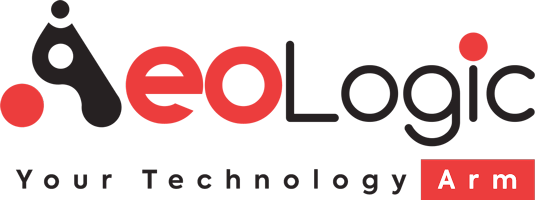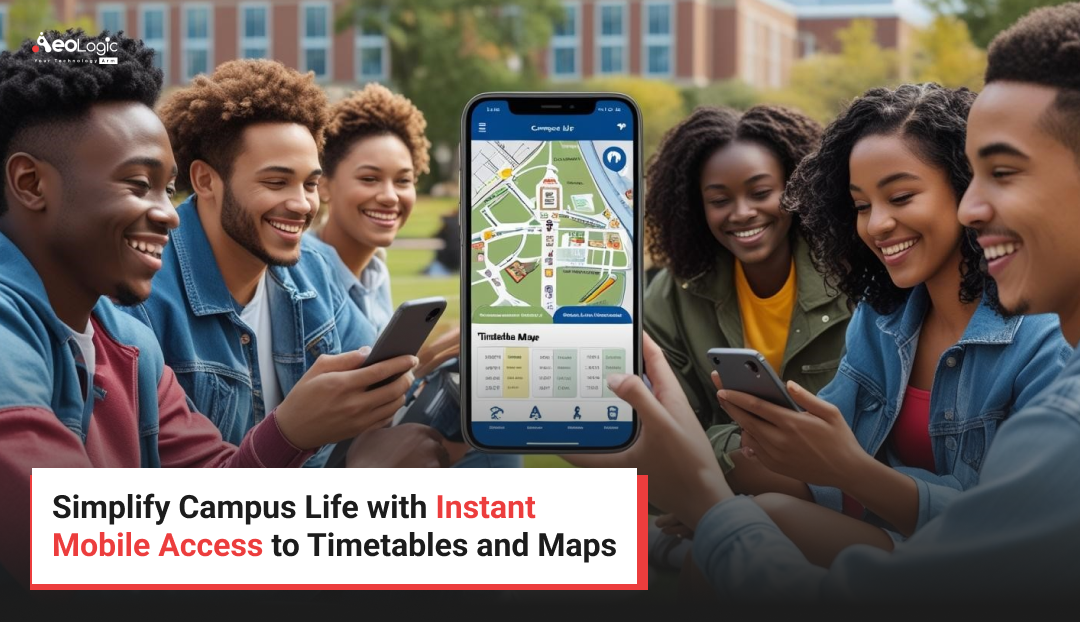A Smarter Way to Experience Campus Picture this:
It’s your first day on campus. You are trying to juggle your class schedule, figure out where the biology lab is, and where the cafeteria is hiding. You have no idea if the unfamiliar buildings are close or far apart, new faces are all around you, and you can never get your bearings in the hallways. Now picture all that stress erased with a simple scan of your smartphone. Welcome to the world of mobile solution for education: A world where your class schedule is updated in real-time, your interactive campus map tells you exactly where to go, and your feedback is submitted in seconds. This digital transformation is not just about convenience but is a means to a more engaging, inclusive, efficient and connected campus experience.
Now imagine: a student opens their phone and sees their updated timetable for the day with rooms and professors color-coded, the student taps and pulls up an interactive map to get from the library to their next lecture, and later the student shares their thoughts on a guest lecture through an anonymous feedback form, knowing their voice is being heard. This is not the future, it’s the present. Colleges and universities around the world are adopting mobile-first strategies to improve and simplify the everyday experience of campus life. This blog discusses how technology such as QR timetables, smart navigation, and mobile feedback is changing student journeys—and why now is the time to embrace it.
Why Mobile Access Makes All the Difference in Education
QR Timetables:
Paper Timetables Can Take a Hike Gone are the days of squinting at corkboards or scanning overcrowded notice walls to find your next class. Enter QR code timetables—a quick scan gives you immediate access to a clear and updated version of your own mobile timetable. Whether you are an anxious first-year student trying to make sense of your first semester, or a fifth-year student trying to manage your electives, QR scheduling tools put clarity and agency in your hands.
Students can: Get class notifications real-time when a class is canceled or modified (and in some cases, moved) Integrate their timetables to their own calendar applications (Google, Outlook, Apple Calendar etc.). Search/filter their classes by course heading, or professor, or credit hours to save time. It’s not only about the technology; it’s about ease of mind. No more racing across campus to find out your class was canceled and the room is vacant. QR timetables allow everything to be correct and accessible in an instant.
Real Impact: After receiving QR timetables in 2023, Delhi University observed a decrease in student inquiries related to timetable confusion by 75%. The faculty and administrative teams understood they had saved dozens of hours in weeks by being able to minimize these conversations.
There’s also an environmental benefit! When we stop needing printed schedules and paper copies to update, schools are creating a more sustainable campus with reduced paper waste—an important step for today’s environmentally-conscious students.
Campus Navigation:
A Never Lose Again Solution Let’s be honest, navigating a large university campus can feel like navigating a new city. Buildings with similar names, poor signage, or unforeseen construction zones can disrupt even the most orderly student. That’s where mobile campus navigation is a game changer. With just a smartphone, students can access interactive maps which show where they are and where they need to be. No more wandering hallways or showing up late for class because you couldn’t find the right building. Modern mobile navigation solutions have already come a long way—there are now an infinite number of advanced mobile navigation solution for education, often with the following:
- Indoor wayfinding via GPS method, Bluetooth beacons, and Wi-Fi triangulation
- Building directories with search options by department, building, or professor
- Points of interest like ATMs, cafes, washrooms, student service areas, safety stations etc.
- It is a great solution for new students, especially during orientation, and just as useful for visitors or guest presenters who are navigating an unfamiliar campus.
Real World Use: At the University of Melbourne, when they integrated campus navigation into their official student mobile app, their orientation week was considerably less stressful. And as a result, they saw an immediate 40% drop in directional inquires and an increase in on-time class attendance in the first two weeks.
Mobile Feedback Forms:
Feedback in Real-time: How many times did students say to themselves, “I wish I could provide feedback right now” but then never actually submitted that survey weeks later? Traditional feedback methods often, disappointingly, arrive too late. Mobile feedback forms make it possible for students to participate in a feedback process at a time where it matters most.
After a lecture, after a campus event, after an interaction with a service department, mobile forms allow students to easily:
Share their input from their phone remain anonymous, which provides students with an honest outlet free of repercussions
Provide educators or support staff with real-time alerts allowing for timely interventions
These forms of technology do more than solicit data, they facilitate more than just change. Educators can refine course material in mid-semester, student services can expedite the process of addressing complaints, planners can troubleshoot with instant on-the-carpet adjustments, etc.
Additionally, mobile feedback systems often yield increased participation rates when compared to traditional survey formats via email. This is likely because mobile feedback requests are:
- – quick, involving low effort
- – contextual, just-in-time – happening just afterwards in “real-time”
- – immediately accessible
What the Data are Saying: In an article highlighting mobile feedback in EdTech magazine, they cited an institution in Canada that saw mobile feedback participation increase by up to 50% and report on student satisfaction improve in a single semester after implementing mobile feedback.
Advantages for Stakeholders
For Students The mobile-first model provides focused tools that change the way students manage the range of activities they engage in, both academic and non-academic. Students are able to navigate their way through their schedules quickly and efficiently by providing real-time information with a couple taps in their mobile device, removing some of the burden of hopping from a new space mentally while traversing a large campus. No more wondering – your day is now plotted and ready to go. Confidence your navigation is successful – exploring a large, new, campus can be overwhelming. Being able to provide feedback – student feedback forms allow students to influence actions taken by the campus The mobile-first commitments does not only extend to academic success, but is also in part designed to support student wellness by alleviating stress and uncertainty.
For Faculty & Administrators
Faculty and campus staff experience the same benefits, if not more, by having streamlined communication and insights. Less redundancy in responses from staff – their streamlined communication means less email and less redundant interruption on their work. Real-time data dashboards – faculty will be better positioned to plan lessons, by knowing the attendance, engagement and feedback of students
Happier students – student satisfaction positively influences retention and leads to better learning outcomes.
Rather than succumbing to motivating students by providing detail responses on logistics, faculty can spend more time in practice, mentor and innovate.
Implementation Guide: How to Deploy Mobile Solution for education on Campus
Deploying a mobile solution for education on campus may seem overwhelming, but it doesn’t have to be. With proper planning on roll out strategies, even the most complex digital systems can lead to quick and easy adoption from students and staff. The right roll out also relies on ease of use, onboarding, and clear communication. Finally, once the tools given to students and staff start to show results, the results will speak for themselves!
Step 1: Choose a Platform
- Pick a platform that checks all of the boxes:
- QR codes for timetables and wayfinding
- Calendar integration for synchronizing schedules
- Real time maps with mobile experience
- Feedback collection tools and cloud computing capabilities
Bonus: Look for solutions with easy update options and perhaps scalable packages for large or small institutions.
Step 2: Onboard Students and Staff
- An effective program is software that is easy to use. For onboarding provide:
- Quick-start guides (print and digital)
- Live or recorded demonstrations during classes or orientation events
- Help desk or chat support for launch week A seamless rollout will instill early trust, and allow users to feel comfortable.
Step 3: Spread the Word About the Fix
- Adoption is fuelled by awareness. Employ a multi-channel approach to communication:
- Posters with QR codes should be placed in busy campus locations.
- Post student endorsements and instructional videos to YouTube or Instagram.
- Add it to campus newsletters and welcome emails.
- You want your students to be able to find the solution anywhere they look
Step 4: Assess and Modify
- Monitor and improve your strategy over time:
- Do students scan their timetables using QR codes?
- How many forms of feedback are being sent in?
- Which buildings receive the most hits on the map?
Overcoming Typical Obstacles
Even the most advanced technology may encounter some difficulties. However, you can transform obstacles into opportunities if you take the initiative.
“Will it be used by everyone?”
It’s acceptable that not all instructors or students will embrace the system right away. Begin by implementing a pilot program in a single department or year group. Provide modest rewards such as early access to premium features, cafeteria discounts, or participation badges. Your greatest marketing tool may be the recommendations of happy early adopters.
“What about data security?”
This is a top concern—and rightly so. Choose platforms that comply with GDPR and FERPA regulations. Look for features like encrypted storage, multi-factor authentication, and secure sign-ins. Make sure your tech partner has experience working with educational institutions and a strong track record of data compliance.
“Is it expensive?”
Cost doesn’t have to be a barrier. Many mobile solution for education offer modular pricing, letting you pay only for what you need. Educational discounts and grants may also be available. Start with core features like QR timetables and feedback forms, then scale up as adoption grows and budget allows.
Frequently Asked Questions
Q: What does mobile solution for education mean in the context of education?
A: It means any device that offers access to academic, and school information is mobile friendly.
Q: Are QR timetables updatable?
A: Indeed! All updates can be made in real-time by administrators without the need of any printing.
Q: Is it possible to navigate within the building?
A: Yes, with the aid of beacon technology or Wi-Fi triangulation.
Q: Is it possible to provide feedback without identifying oneself?
A: Certainly. Many mobile forms have settings that allow users to remain anonymous, which helps to capture honest feedback.
So, smart campuses?
It all starts with the right tools. These days, everyone expects to be able to use their phones for everything. With things like QR code schedules, maps of the campus, and quick feedback forms, you can make student life easy to figure out, quick, and give students more control.
Want to make campus life better? Get in touch With Aeologic Technologies as your trusted tech solution partner, you can leverage cutting edge AI innovations to transform your contact center operations. The gen AI financial services are just beyond our imagination and have a brighter future than today. This not only improves the way of contact services but also introduces an innovation that is going to enhance the financial sector for a long time.

Currently, as a Senior Manager of Technology, I oversee a dynamic team, ensuring the delivery of high-quality software solutions that meet the evolving needs of our clients. A seasoned technology leader with over a decade of experience in the software development industry, I have been instrumental in driving the end-to-end software development lifecycle since my career inception in 2011.






